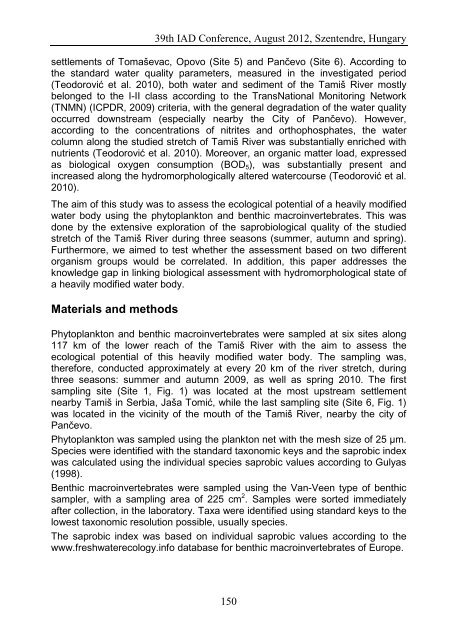Conference Proceedings - IAD
Conference Proceedings - IAD
Conference Proceedings - IAD
You also want an ePaper? Increase the reach of your titles
YUMPU automatically turns print PDFs into web optimized ePapers that Google loves.
39th <strong>IAD</strong> <strong>Conference</strong>, August 2012, Szentendre, Hungary<br />
settlements of Tomaševac, Opovo (Site 5) and Pančevo (Site 6). According to<br />
the standard water quality parameters, measured in the investigated period<br />
(Teodorović et al. 2010), both water and sediment of the Tamiš River mostly<br />
belonged to the I-II class according to the TransNational Monitoring Network<br />
(TNMN) (ICPDR, 2009) criteria, with the general degradation of the water quality<br />
occurred downstream (especially nearby the City of Pančevo). However,<br />
according to the concentrations of nitrites and orthophosphates, the water<br />
column along the studied stretch of Tamiš River was substantially enriched with<br />
nutrients (Teodorović et al. 2010). Moreover, an organic matter load, expressed<br />
as biological oxygen consumption (BOD5), was substantially present and<br />
increased along the hydromorphologically altered watercourse (Teodorović et al.<br />
2010).<br />
The aim of this study was to assess the ecological potential of a heavily modified<br />
water body using the phytoplankton and benthic macroinvertebrates. This was<br />
done by the extensive exploration of the saprobiological quality of the studied<br />
stretch of the Tamiš River during three seasons (summer, autumn and spring).<br />
Furthermore, we aimed to test whether the assessment based on two different<br />
organism groups would be correlated. In addition, this paper addresses the<br />
knowledge gap in linking biological assessment with hydromorphological state of<br />
a heavily modified water body.<br />
Materials and methods<br />
Phytoplankton and benthic macroinvertebrates were sampled at six sites along<br />
117 km of the lower reach of the Tamiš River with the aim to assess the<br />
ecological potential of this heavily modified water body. The sampling was,<br />
therefore, conducted approximately at every 20 km of the river stretch, during<br />
three seasons: summer and autumn 2009, as well as spring 2010. The first<br />
sampling site (Site 1, Fig. 1) was located at the most upstream settlement<br />
nearby Tamiš in Serbia, Jaša Tomić, while the last sampling site (Site 6, Fig. 1)<br />
was located in the vicinity of the mouth of the Tamiš River, nearby the city of<br />
Pančevo.<br />
Phytoplankton was sampled using the plankton net with the mesh size of 25 µm.<br />
Species were identified with the standard taxonomic keys and the saprobic index<br />
was calculated using the individual species saprobic values according to Gulyas<br />
(1998).<br />
Benthic macroinvertebrates were sampled using the Van-Veen type of benthic<br />
sampler, with a sampling area of 225 cm 2 . Samples were sorted immediately<br />
after collection, in the laboratory. Taxa were identified using standard keys to the<br />
lowest taxonomic resolution possible, usually species.<br />
The saprobic index was based on individual saprobic values according to the<br />
www.freshwaterecology.info database for benthic macroinvertebrates of Europe.<br />
150
















